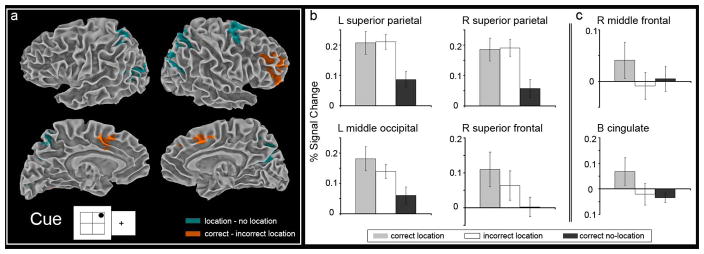Figure 1.

Experimental design. a, Example of the encoding task used in the scanner illustrating the sequential presentation of a spatial cue (with present or absent location information) and an object. A trial consisted of a 2-s spatial cue grid, followed by a 0.5-s associative cue (plus-sign), a blank screen jittered delay of 0 to 13 s, and finally a 2-s object. A blank screen was present during an intertrial interval of 0.5 to 13.5 s. The jittered delay periods and intertrial intervals were calculated to optimize the study design for modeling the hemodynamic response to trials [25]. When a circle was present in one of the grid quadrants, subjects were instructed to imagine and remember the following object (e.g., football) as located in that quadrant. When the grid was blank, subjects were instructed to just remember the following object (e.g., broccoli). b, Example of the post-scan recognition test. Subjects were shown each object previously viewed during the encoding task as well as novel objects, and they were asked to rate their confidence that the picture (e.g., football) was new or that it was shown during the scan (old) on a scale from “definitely new” to “definitely old.” If the object was included in the encoding task, subjects were asked a follow-up question regarding the object’s associated spatial information. Subjects responded 1–4 to identify the object’s associated location, 5 to select that the object had no location, or 6 to say they were unsure about the object’s location.
